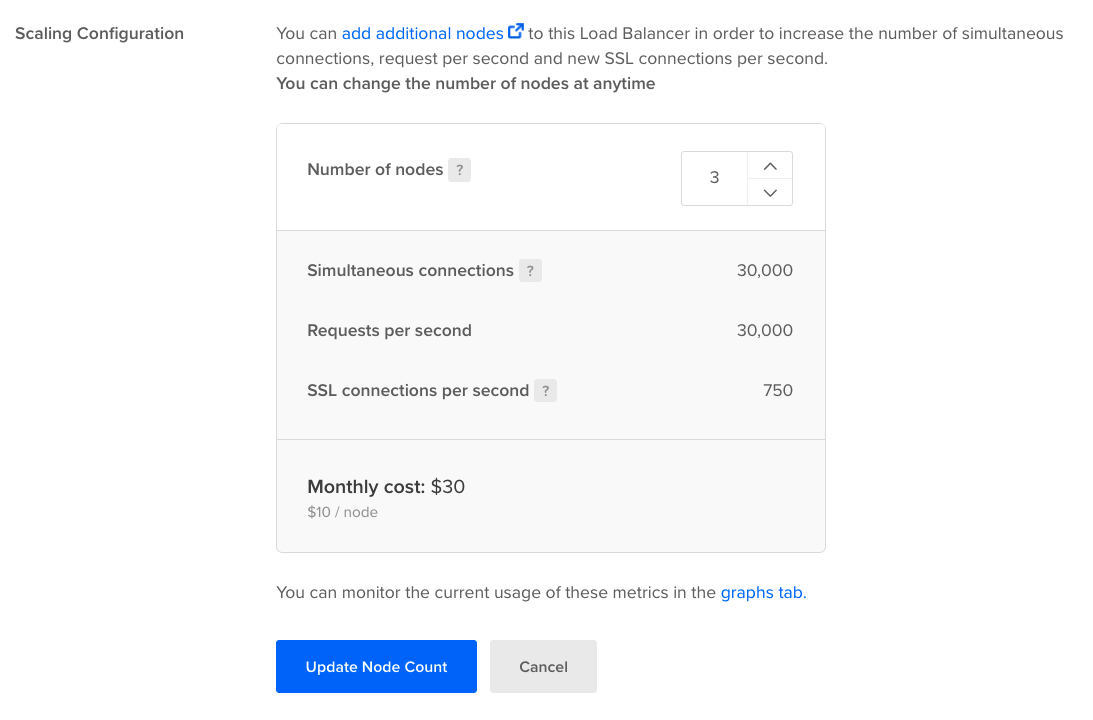cURL
To scale a load balancer with cURL, call:
curl -X PUT \
-H "Content-Type: application/json" \
-H "Authorization: Bearer $DIGITALOCEAN_TOKEN" \
-d '{"name":"example-lb-01","size_unit":"2","region":"nyc3","algorithm":"least_connections","forwarding_rules":[{"entry_protocol":"http","entry_port":80,"target_protocol":"http","target_port":80},{"entry_protocol":"https","entry_port":444,"target_protocol":"https","target_port":443,"tls_passthrough":true}],"health_check":{"protocol":"http","port":80,"path":"/","check_interval_seconds":10,"response_timeout_seconds":5,"healthy_threshold":5,"unhealthy_threshold":3},"sticky_sessions":{"type":"cookies", "cookie_name": "DO_LB", "cookie_ttl_seconds": 300}, "firewall":{"deny":["ip:1.2.3.4","cidr:2.3.4.0/24"], "allow":["cidr:1.2.0.0/16","ip:2.3.4.5"]}, "droplet_ids": [3164444, 3164445]}' \
"https://api.digitalocean.com/v2/load_balancers/4de7ac8b-495b-4884-9a69-1050c6793cd6"
Go
Go developers can use Godo,
the official DigitalOcean V2 API client for Go. To scale a load balancer with Godo, use the
following code:
import (
"context"
"os"
"github.com/digitalocean/godo"
)
func main() {
token := os.Getenv("DIGITALOCEAN_TOKEN")
client := godo.NewFromToken(token)
ctx := context.TODO()
updateRequest := &godo.LoadBalancerRequest{
Name: "example-01",
SizeUnit: "2",
Algorithm: "round_robin",
Region: "nyc3",
ForwardingRules: []godo.ForwardingRule{
{
EntryProtocol: "http",
EntryPort: 80,
TargetProtocol: "http",
TargetPort: 80,
},
{
EntryProtocol: "https",
EntryPort: 443,
TargetProtocol: "https",
TargetPort: 443,
TlsPassthrough: true,
},
},
HealthCheck: &godo.HealthCheck{
Protocol: "http",
Port: 80,
Path: "/",
CheckIntervalSeconds: 10,
ResponseTimeoutSeconds: 5,
HealthyThreshold: 5,
UnhealthyThreshold: 3,
},
StickySessions: &godo.StickySessions{
Type: "cookies",
CookieName: "DO_LB",
CookieTtlSeconds: 300,
},
DropletIDs: []int{3164444, 3164445},
RedirectHttpToHttps: false,
Firewall: &godo.LBFirewall{
Deny: []string{"ip:1.2.3.4", "cidr:2.3.4.0/24"},
Allow: []string{"cidr:1.2.0.0/16", "ip:2.3.4.5"},
}
}
lb, _, err := c.LoadBalancers.Update(ctx, "c2c97ca7-6f63-4e23-8909-906fd86efb5e", updateRequest)
}
Ruby
Ruby developers can use DropletKit,
the official DigitalOcean V2 API client for Ruby. To scale a load balancer with DropletKit, use the
following code:
require 'droplet_kit'
token = ENV['DIGITALOCEAN_TOKEN']
client = DropletKit::Client.new(access_token: token)
load_balancer = DropletKit::LoadBalancer.new(
name: 'example-lb-01',
size_unit: '2',
algorithm: 'round_robin',
droplet_ids: [ 3164444, 3164445],
redirect_http_to_https: true,
region: 'nyc3',
forwarding_rules: [
DropletKit::ForwardingRule.new(
entry_protocol: 'http',
entry_port: 80,
target_protocol: 'http',
target_port: 80,
certificate_id: '',
tls_passthrough: false
),
DropletKit::ForwardingRule.new(
entry_protocol: 'https',
entry_port: 443,
target_protocol: 'https',
target_port: 443,
certificate_id: '',
tls_passthrough: true
)
],
sticky_sessions: DropletKit::StickySession.new(
type: 'cookies',
cookie_name: 'DO-LB-COOKIE',
cookie_ttl_seconds: 5
),
health_check: DropletKit::HealthCheck.new(
protocol: 'http',
port: 80,
path: '/',
check_interval_seconds: 10,
response_timeout_seconds: 5,
healthy_threshold: 5,
unhealthy_threshold: 3
)
)
client.load_balancers.update(load_balancer, id: '4de7ac8b-495b-4884-9a69-1050c6793cd6')
Python
import os
from pydo import Client
client = Client(token=os.environ.get("DIGITALOCEAN_TOKEN"))
req = {
"name": "updated-example-lb-01",
"region": "nyc3",
"droplet_ids": [
3164444,
3164445
],
"algorithm": "round_robin",
"forwarding_rules": [
{
"entry_protocol": "http",
"entry_port": 80,
"target_protocol": "http",
"target_port": 80,
"certificate_id": "",
"tls_passthrough": false
},
{
"entry_protocol": "https",
"entry_port": 443,
"target_protocol": "https",
"target_port": 443,
"certificate_id": "",
"tls_passthrough": true
}
],
"health_check": {
"protocol": "http",
"port": 80,
"path": "/",
"check_interval_seconds": 10,
"response_timeout_seconds": 5,
"healthy_threshold": 5,
"unhealthy_threshold": 3
},
"sticky_sessions": {
"type": "none"
},
"redirect_http_to_https": False,
"enable_proxy_protocol": True,
"enable_backend_keepalive": True,
"vpc_uuid": "c33931f2-a26a-4e61-b85c-4e95a2ec431b",
"project_id": "9cc10173-e9ea-4176-9dbc-a4cee4c4ff30",
"http_idle_timeout_seconds": 60,
"firewall": {
"deny": [
"cidr:1.2.0.0/16",
"ip:2.3.4.5"
],
"allow": [
"ip:1.2.3.4",
"cidr:2.3.4.0/24"
]
}
}
resp = client.load_balancers.update(lb_id="fda9fda", body=req)

